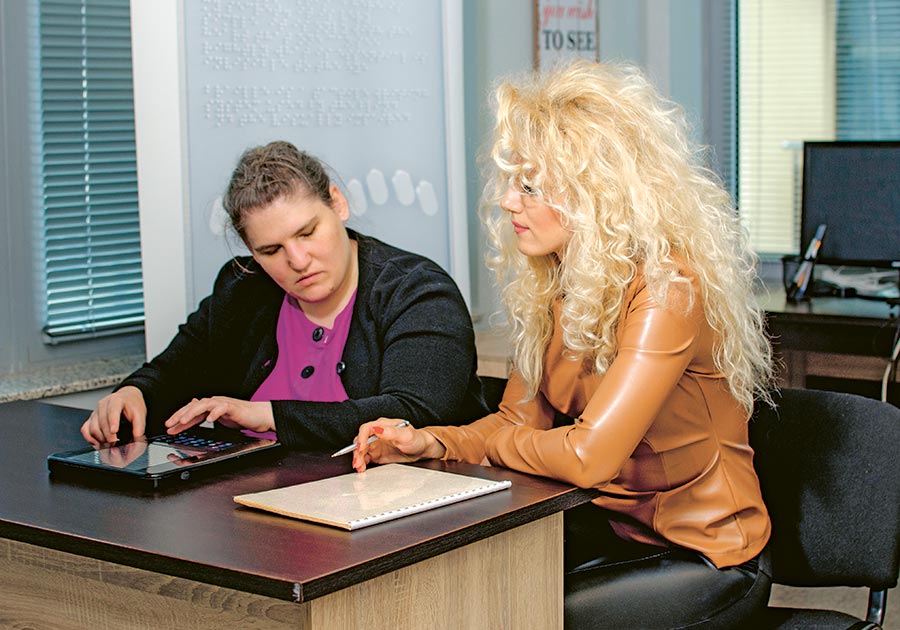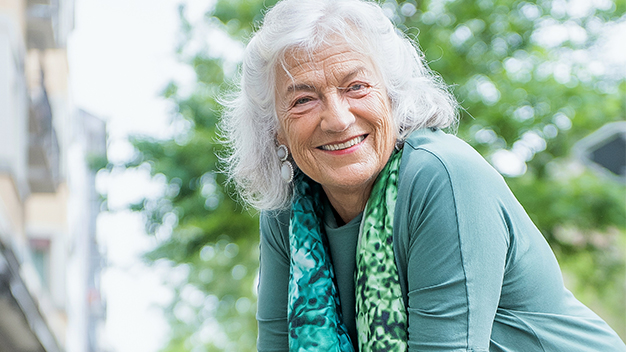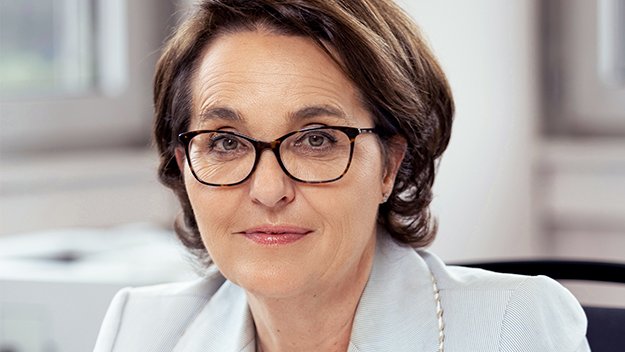Text: Eric Johnson | Photos: Blitab | Magazine: Homo digitalis – June 2018
#founder #social_entrepreneur #competitive
. . . PCs, smartphones and other electronic gadgets are in certain instances difficult-to-impossible to use. A Vienna-based start-up, led by Kristina Tsvetanova, aims to overcome that, to offer “digital inclusion” for the sightless. The product is Blitab, an e-tablet that functions in Braille.
She’s used to pioneering. As one of the few women in her year to study Industrial Engineering, she went on to win awards from her university and from Bulgaria’s Ministry of Education. Now, she’s one of the rare females in the manly technology industry, and she’s championing a product that takes e-tablets into unexplored territory. Kristina Tsvetanova talked to ceo magazine about her product and about modern, digital life.
How does a blind person typically use Blitab?
First let me tell you what blind people used before Blitab. There are “blind reading” devices in the market today: they look something like a PC keyboard, and they display one line of Braille (the tactile writing system used by the visually impaired). So users can read about five words at a time. To read a full book the size of, say, “Harry Potter”, can take months! If they fall asleep or lose their place, it’s very difficult for them to find where they left off. They can’t “see” graphics or images. And on top of that, the current devices retail at prices of USD 5,000 to USD 10,000.
This is why we set out to create Blitab. We present an entire page of text, images and graphics. It can be used very similarly to how sighted people use e-tablets such as an iPad. Blitab converts conventional outputs of various apps into electronic Braille, little dots (called tixels) that go up and down to form the various alphanumeric characters plus shapes and surfaces. And it will be affordable: we are aiming at a retail price of around USD 500.
“In five to ten years, we hope to see an increase in Braille usage and most of all, more social inclusion of the blind.”
Why Braille and not text-to-speech?
Blitab does enable text-to-speech, but we believe in Braille. Just as sight reading is so much faster than speech, so too is Braille. This allows the blind to get through more in less time. Of course, the blind need to learn to read and write Braille, and to some extent they’ve moved away from this with the increasing availability of text-to-speech. But we believe that if Braille can make texts fully, quickly available as it is on Blitab, then there will be incentive to keep using this amazing tactile system for communicating.
While studying Industrial Engineering in the early millennium at Bulgaria’s University of Sofia, Kristina Tsvetanova saw visually impaired students struggling to learn and to communicate. Their tenacity inspired her to try to end their “digital exclusion”. After several technical jobs in Sofia and then Vienna, in 2014 she joined two other Bulgarians (brothers Slavi and Stanislav Slavev) to found Blitab. She lives a typical “start-up life”, with a hectic schedule full of problem-solving, investor relations and travel. Indeed, ceo magazine spoke to her while she was on a fund-raising tour of Silicon Valley.
How far away is a commercial product?
Going from nothing, to a concept, to a prototype, to a commercial product is a long road indeed. We started in 2014, and there were times when we nearly gave up. But we made it through those dips and now we’re into pre-production and fund-raising to get on with serious manufacturing. We expect to close our first round of financing and enter the market by the end of 2018.
When and where might Blitab be available, and how will you sell it?
We expect to sell it via two channels. One is conventional retailers who sell “blind-assistive” products and Braille devices. The other is government agencies and companies who do business with the blind. For instance, we’re talking to banks who might resell Blitab to make their services more accessible for the visually impaired. We’ve also approached telecoms such as T-Mobile, who are interested in using Blitab because it is SIM-card compatible. We hope to capture 10 to 20 per cent of the existing market for assisted products. If we can help re-energise the use of Braille, which we hope to do, the sky’s the limit.
Where do you see Blitab in five to ten years?
We believe Blitab is a game-changer, like the iPad was. An ecosystem of apps is our goal, replete with maps, special education offerings and all the kinds of services that sighted people use, just adapted to the sightless. We’re constantly sending out our API (an electronic interface for app developers) to people who want to create new apps for Blitab –
they’re more than welcome to do so. We’re also developing digital services that connect to the device. In five to ten years, we hope to see an increase in Braille usage and most of all, more social inclusion of the blind.
How are they excluded today?
There are some 300 million blind people, most of whom cannot access digital content. Many just use paper and punch Braille. We want to give them better access to all the amazing apps that are out there. We also want to make this access affordable. And I’m pleased to say that we are not alone: other devices will help the blind, too.
Such as . . . ?
Self-driving cars, for instance. And robots – these could be a tremendous help, not just to the blind. The same robots that keep blind people safe from traffic can protect small children and people with other disabilities as well. Work is in progress on drones that can guide people – tell them where the street, the shop or the traffic light is. There’s also work underway to develop robotic guide “dogs”. Real animals are of course wonderful, but also very expensive to train and maintain. Robots could help supplement their work.
Blitab is, as the name implies, an e-tablet that presents any document (text plus graphics) to the blind, converts text to speech and allows inputs from Braille typewriters (called Perkins-style keyboards). The e-tablet, which looks much like a conventional one for sighted people, is a platform – meaning it does not displace existing applications, but instead makes them useable by the sightless. The company has won several innovation awards, and last year, Blitab made its commercial debut at the industry-leading Consumer Electronics Show in Las Vegas.
www.blitab.com
To what extent has digitalisation impacted your life?
If it weren’t for digitalisation, my company would not exist. We couldn’t even have this conversation (NB: the interview was conducted via Skype). My life is very digitalised. When I go to the gym to work out, or go for a run, I use digital trackers. At the office, I could barely get things done without my gadgets and Bluetooth and the rest. A few years ago, I never thought robots would enter my private life. Now, I’ll be out shopping, and a notification goes off on my smartphone telling me that the shop around the corner is offering a special discount on something I want – just for me! Digitalisation expands your possibilities as a person, and it gives you more time.
Do you use a “digital assistant”?
I use Google Assistant, which looks like a big candle. It’s connected to Bluetooth, and I tell it to play music or I ask questions about things like the weather. Sometimes I say something not directed to the assistant, and she starts talking to me unprompted – this always surprises me.
“With today’s ‘blind reading’ devices, it takes months to read a book the size of a ‘Harry Potter’ novel.”
Do you see any downsides to digitalisation?
Loss of privacy is probably the number one concern. I’ve closely followed the public discussion about Facebook and Cambridge Analytica and the protection of personal data. One weakness of so much digitalisation is that users either don’t know or don’t remember what data they agreed to give away. We want services at low cost, but we want privacy: the line between them is still being defined.
24/7 working and accessibility: what’s your view?
People today cannot afford to be available 24/7; as this was not possible for most people in the past. Devices, however, clearly can work 24/7. Still, there are areas where devices won’t easily replace people, for instance in healthcare or art, where emotions and human connections are still needed.
What’s the next big thing?
A few weeks ago, I attended a virtual presentation where the lecturer was a hologram. It seemed as if she really was there in the room. The technology is not commercial yet, but it’s coming. It’ll reduce a lot of the cost, time and effort involved in meetings.
Any final comments?
I want to help the blind, and I want to bring men and women together. Males and females are equal, but they are of course different. I think we can have a world of diversity, sustainability and social inclusion. That’s my dream.
Kristina Tsvetanova
Short questions – short answers
Describe yourself in 3 hashtags.
#Female founder #Social entrepreneur #Competitive
What is your favourite app?
I don’t have a single favourite. In my free time, my fitness app gets a lot of use. When I’m on the job, it’s Bloomberg Technology.
What’s the background image on your phone or PC?
A female runner at the starting line, getting ready to race a tiger. This motivates me to keep getting better.
As a child, what was your dream job? How did you choose your current career?
As a child, I put my dolls in a row and taught them: I was a teacher. Now, my dream is to be a leader and to show how things should work.
Can you remember your first mobile phone?
A Motorola Clipper, with a flip screen and colour display. It was amazing, and it still works.





